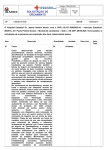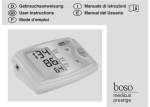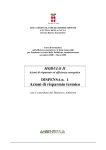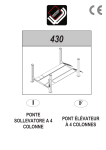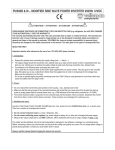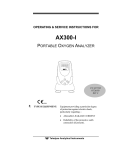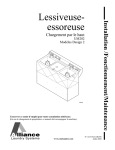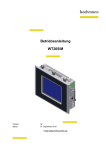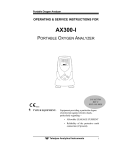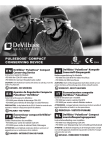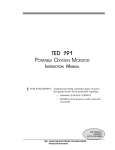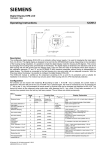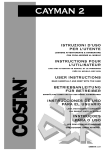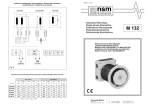Download TED 60-T - Teledyne Analytical Instruments
Transcript
TED 60-T PORTABLE OXYGEN ANALYZER TOR'S MANUAL OPERA PERATOR TYPE B EQUIPMENT: Equipment providing a particular degree of protection against electric shock, particularly regarding— • allowable LEAKAGE CURRENT • Reliability of the protective earth connection (if present). P/N M40575 12/08/99 ECO # 99-0480 Teledyne Analytical Instruments i Copyright © 1999 Teledyne Electronic Technologies, Sensor Technologies All Rights Reserved No part of this manual may be reproduced, transmitted, transcribed, stored in a retrieval system, or translated into any other language or computer language in whole or in part, in any form or by any means, whether it be electronic, mechanical, optical, manual, or otherwise, without prior written consent of Teledyne Electronic Technologies, Sensor Technologies, 16830 Chestnut Street, City of Industry, CA 91749–1580. ii Teledyne Analytical Instruments How To Use This Manual This manual is designed to walk you through the initial set-up of the TED 60T. After you have used it to initially install your analyzer, it becomes a quick reference guide to help you with specific questions or operating problems. Before you even turn on the instrument, you are advised to read Chapters 1 and 2. These chapters help you to become better acquainted with the monitor and how it works before you actually begin to use it. Please read Chapter 2: Operations in its entirety before proceeding further with the manual. Teledyne Analytical Instruments iii Warranty Teledyne warrants that the goods are free from defects of material and of constuction for a period of 2 years from the date of shipment from Teledyne. The Class T-7 MicroFuel Cell is warranted for one year from the date of shipment from Teledyne. The liability of Teledyne, if any, shall be limited solely to the replacement and repair of the goods and shall not include shipping costs or other incidental damages as defined in Section 2-715 of the U.S. Uniform Commercial Code. This warranty is null and void if any goods are subjected to misuse, negligence, accident, or repairs other than those performed by Teledyne or an authorized service center. Caution: Federal law restricts this device to sale by or on the order of a physician. iv Teledyne Analytical Instruments Tab le of Contents able 1 Introduction General Information ...................................................................................... 1-1 Applications .................................................................................................. 1-2 2 Operations Setup .......................................................................................................... 2-1 Battery Installation ............................................................................ 2-1 Sensor Installation or Replacement .................................................. 2-2 Calibration ......................................................................................... 2-3 Use .......................................................................................................... 2-3 Sterilization ....................................................................................... 2-4 Anesthetic Gases ............................................................................... 2-4 Pressure ............................................................................................. 2-5 Humidity............................................................................................ 2-6 Temperature ...................................................................................... 2-6 Discrepancy in Readings ................................................................... 2-7 Do's & Don'ts ................................................................................................ 2-8 3 Maintenance and Troubleshooting Troubleshooting Table .................................................................................. 3-1 4 Appendix Specifications ................................................................................................ 4-1 Spare Parts List ............................................................................................. 4-2 Optional Accessories..................................................................................... 4-2 Repair Service ............................................................................................... 4-2 Material Safety Data Sheet ........................................................................... 4-3 Teledyne Analytical Instruments v vi Teledyne Analytical Instruments Introduction 1 Introduction General Information The Teledyne Electronic Technologies 60T Oxygen Analyzer provides analysis in respirators, incubators, and other medical equipment where specific monitoring of oxygen is vital. The unit is compact, light, fits comfortably in a pocket, and incorporates a belt clip for easy carrying. Its 9-volt battery lasts about one year in normal service. The TED 60T utilizes the Class T–7 Micro-Fuel Cell specifically designed for medical applications. The sensor is a self-contained galvanic cell with a 90% response time of typically 6–8 seconds at 5 liters/minute and a life expectancy of 10 months in 100% oxygen (continuous). Replacing the sensor is as easy as unclipping the old sensor and snapping on a replacement. The low-cost sensor also has an excellent shelf life that makes keeping spares a sensible proposition. Front view of the TED 60-T Teledyne Analytical Instruments 1-1 1 Introduction The TED 60T incorporates a combination of important features. The liquid crystal display (LCD) provides an easy-to-read indication of the oxygen content of the gas being monitored, with a resolution of 1% oxygen. The upper left-hand corner of the LCD indicates “BAT” when the batteries are low. Located on the top panel of the monitor are the ON/OFF power switch and the calibration control button. The battery is located in the back beneath a sliding cover. The Class T–7 Micro-Fuel Cell is the heart of the TED 60T. The sensor is connected to a coiled cable one foot (0.3 meter) long which extends to about five feet (1.5 meters). Applications The TED 60T is designed to analyze oxygen concentrations in a variety of medical gas mixtures. This instrument should never be used as a primary monitoring device. It is recommended that the instrument only be used as a secondary measuring device to verify and spot check the concentration of oxygen in gas mixtures prepared using a gas blender, anesthesia gas machine, or similar apparatus. The unit may be used for verifying oxygen concentrations in gas mixtures used in: • Anesthesia • Respiratory Therapy • Neonatal Care • Intensive Care RFI Immunity The Teledyne Model TED 60-T has been tested to the standard required by the European Community for CE marking, EN 60601-1-2. The sample subjected to testing passed all sections of this testing with the exception of the following: From 26MHz to 250MHz, the display was unstable. When interference was removed, the equipment under test recovered. From 250MHz to 1000MHz, the display was stable. 1-2 Teledyne Analytical Instruemnts Operations 2 Operations s CAUTION: UPON RECEIPT, INSPECT THE ENTIRE UNIT FOR DAMAGE. CHECK UNIT AND INCLUDED ACCESSORIES FOR BROKEN OR LOOSE PARTS. IF DAMAGED, DO NOT USE; NOTIFY THE SHIPPER; AND CONSULT TBE SENSOR TECHNOLOGIES. NOTE: This equipment is internally powered. Setup To set up and use your TED 60T: 1 2 3 Install the battery. Install the sensor. Calibrate the unit. Battery Installation or Replacement NOTE: A 9-volt alkaline battery must be installed in the unit before the TED 60T can operate. NOTE: When new batteries are installed, typically, the unit is suitable for use immediately after installation. 1. Turn the unit off (if it is on). 2. Open the battery compartment door. (The battery compartment is below the belt clip on the rear of the unit. The door slides downward in the direction of the arrow.) 3. Lift the battery from its compartment and unsnap it from the snap connector. 4. Snap the new battery to the snap conector. (Match up the male and female snaps. The battery snap connector will only accept a properly oriented battery. Do not try to force it. Teledyne Analytical Instruments 2-1 2 Operations CAUTION: USE ALKALINE BATTERIES ONLY. OTHER TYPES MAY GIVE ERRONEOUS READINGS. If “BAT” appears in the upper left-hand corner of the LCD, the battery needs replacing. Sensor Installation or Replacement NOTE: The T-7 oxygen sensor must be installed before the TED 60T will operate. NOTE: When a new sensor is installed, typically, the unit is suitable for use immediately after installation. CAUTION: Do not autoclave the sensor. See page 2.4, Sterilization. 1. Remove the new sensor from its protective bag. Inspect the sensor for damage or electrolyte leakage. If the sensor is damaged, obtain a replacement. Do not use the defective sensor as it may damage the unit. CAUTION: The T–7 sensor electrolyte is caustic. Do not let it come in contact with skin. If it does, flush affected area with water. Do not attempt to open or repair the sensor. Check the sensor regularly for leaks. Leaking or exhausted sensors should be disposed of in accordance with local regulations. Consult the Material Safety Data Sheet in the Appendix. 2. Plug the end of the coiled cable into the telephone jack receptacle on the end of the T-7 sensor, observing proper key orientation. The jack will only fit one way, so if it does not fit, rotate it until it slides in easily. NOTE: If the TED 60T is used for diffusion sampling (i.e., incubators, tents, etc.), the plastic flow diverter must be removed from the T-7 sensor. If the sensor is used in breathing circuits, etc., the diverter must be used. Micro-Fuel Cell Flow Diverter Sensing Surface 2-2 Teledyne Analytical Instruments Tee Adapter Operations 2 Calibration NOTE: Never expose the sensor to varying temperatures (i.e., hold the sensor in your hand) while calibrating. 1. Switch the unit ON using “0/I” ON/OFF key. 2. Place the sensor in 100% oxygen. NOTE: The flow diverter should only be used with flowing gas circuits. 3. The CALIBRATE button is located on the top of the unit. Turn the button by pressing down on it and twisting. Rotate until the display reads 100%. 4. Remove the sensor from 100% oxygen. If the flow diverter is attached, remove it and expose the sensor to room air. The LCD should display 20– 22%. 5. A calibration check may be conducted at any time to assure proper operation. Remove the diverter and expose the sensor to room air, and verify that the reading is 20–22%. Expose the sensor to 100% oxygen (preferably using the diverter and tee adapter in a flow circuit) and verify that the reading is 99–101%. NOTE: Never calibrate the unit in humidified gas, as water vapor dilutes the calibration gas and makes the oxygen concentration appear lower than it really is. Use NOTE: Prior to use, check the calibration and check the sensor for leaks or damage. The TED 60T can be used to analyze gas mixtures for oxygen in two basic modes: 1.) In breathing circuits or other instances where gases are flowing in tubing circuits. 2.) In confined volumes such as incubators or tents. When measuring for oxygen in breathing circuits, the diverter must be used. The diverter should be screwed onto the threaded front end of the T-7 sensor. A tee adapter Teledyne Analytical Instruments 2-3 2 Operations (either plastic, P/N A268, or metal, P/N A283) should be placed into the circuit, and the above sensor assembly plugged into the tee adapter. CAUTION: Check the breathing circuit for leaks. Be certain that the circuit downstream of the sensor does not produce any back-pressure or restriction to flow, or errors in readings will result. When measuring for oxygen in confined volumes such as incubators, hoods, etc., the flow diverter must be removed from the T-7 sensor so that it does not interfere with the rapid exchange of gases to and from the sensing surface of the T-7. CAUTION: Failure to remove the diverter in these application areas will result in a marked lowering of the response time of the sensor. The T-7 sensor can be placed inside incubators, tents, etc. When it is necessary to thread the cable through a small hole in order to gain access to the inside of a chamber, the cable should be disconnected at the sensor, threaded through the hole, and reconnected inside the chamber. Sterilization CAUTION: The sensor must never be immersed in any sterilizing or other solutions, autoclaved, or subjected to high temperatures or vacuums. The TED 60T itself should never be liquid sterilized or autoclaved. The surface of the case may be wiped with isopropyl alcohol and/or mild detergent and allowed to dry in air. Anesthetic Gases When using the T-7 sensor in the presence of anesthetic gases such as Halothane, the oxygen reading may fall (see the table on the following page). The magnitude of this error will depend upon the level of oxygen and the duration of exposure. The anesthetic agents listed in the table (Halothane, Enflurane, Isoflurane, Sevoflurane and Desflurane) were vaporized into a stream of 30% oxygen/70% Nitrous Oxide, and the resulting drops in oxygen level after an exposure of approximately two hours were noted. Exposures in excess of two hours may produce slightly greater errors. The errors listed are typical for all oxygen sensors such as the T-7. Exposing the sensor to air or gases that do not contain anesthetic agents for a period of time equal to or greater than the exposure interval will eliminate the reading error in most cases. 2-4 Teledyne Analytical Instruments Operations 2 Gas or Vapor Level (Balance: Mixture of 30% O2 / 70% N20, except where noted) Gas or Vapor Helium Nitrous Oxide Carbon Dioxide Halothane Enflurane Isoflurane Sevoflurane Desflurane Test Level 50%, balance O2 80%, balance O2 10%, balance O2 4% 5% 5% 5% 15% Oxygen Reading Error 0% 0% 0% < -1.5% O2 * < -1.5% O2 * < -1.5% O2 * < -1.5% O2 * < -1.5% O2 * * Errors are approximate and may vary based on exposure times and concentrations. These performances meet or exceed the requirements of ISO 7767: 1997 (E). CAUTION: The TED 60T should not be used in the presence of flammable anesthetics such as diethyl ether or cyclopropane. As with all galvanic-type oxygen sensors, the T-7 should not be left in nitrous oxide mixtures any longer than absolutely necessary. After exposure to nitrous oxide mixtures, the sensor should be left in 100% oxygen overnight (e.g., left in a breathing circuit that has been flushed with pure oxygen). If this is not practical, the plastic flow diverter should be removed and the sensor left in room air. If the oxygen reading continues to drop after each use in nitrous oxide the sensor should be removed from service. If the sensor can no longer be calibrated or if there is any sign of electrolyte leakage, the sensor should be disposed of in accordance with local regulations and the Material Safety Data Sheet (MSDS) located in the Appendix. Pressure Virtually all oxygen analyzers measure the partial pressure, not the percentage, of the gas that they sense. The only time that these instruments can accurately read percentages is when the total pressure does not vary over time between calibration and use. This is why it is important to calibrate the TED 60T oxygen sensor at regular intervals. It is recommended that the unit be calibrated prior to each use or every 8 hours. When the sensor is connected to a ventilator circuit, the alternating “breathing” pressure cycles generated by the ventilator will be sensed as an increase in the oxygen percentage (especially if the sensor is fast enough to sense the changes, as is the T-7). In reality, the percentage of oxygen is not changing; it is the total pressure that is increasing, producing a corresponding increase in the partial pressure of oxygen. A hundredTeledyne Analytical Instruments 2-5 2 Operations centimeter water pressure pulse will produce a .11 atmosphere, or an 11% increase in the total and therefore partial pressure of oxygen. Assuming that the sensor is fast enough to track this pressure pulse, an unpressurized reading of 50% oxygen will increase to 55.5% if the sensor is subjected to a pressure cycle of 100 cm H2O. The reading will rise proportionally less for smaller pressures. Humidity Humidity does not directly affect the accuracy of the sensor’s measurement. However, when a nebulizer or other device is used to increase moisture levels in gas mixtures, the moisture actually dilutes the mixture. This dilution effect decreases the oxygen concentration. For example, if an 80% oxygen gas mixture is humidified to saturation at room temperature, the resulting gas mixture will contain only 77.5% oxygen. Your TED 60T oxygen analyzer accurately measures decreases in the oxygen concentration due to the dilution effects of moisture added to gas mixtures. Caution: As with all oxygen sensors, excessive condensation on the sensing surface of the T-7 will block the diffusion of oxygen to the sensor, rendering it inoperative. Should this occur, gently wipe the sensing surface of the T–7 with a cotton swab and allow to air dry. To prevent this, TED recommends installing the sensor on the dry side of the breathing circuit at all times. Water condensate on the exposed cable contacts at the rear of the sensor may affect the oxygen reading and should be removed by shaking out the condensed water and allowing the sensor to air dry. Temperature A thermistor circuit in the T-7 oxygen sensor adjusts for ambient temperature changes in the range of 0–40°C (32–104°F). Since the thermistor that compensates for these changes is located in the rear of the sensor assembly, it is important that gas mixtures, flowing over the front of the sensor, be at room temperature. Reading errors may occur if hot gases from a heated humidifier are directed past a sensor teed into a breathing circuit. A small thermal tracking error may be encountered in application areas where the entire sensor assembly is placed in the gas mixture to be analyzed (e.g., incubators). No adjustments should be made during this period (about 1 to 2 hours), since this error will be eliminated when both the thermistor and sensing electrode have had sufficient time to come to thermal equilibrium. 2-6 Teledyne Analytical Instruments Operations 2 Discrepancy in Readings The TED 60T is intended to be used as a secondary means to verify the accuracy of and check the oxygen concentration leaving another oxygen mixing device or primary life support system (i.e., a blender or respirator). Whenever there is a significant difference in the oxygen readings between the primary support system and the analyzer, the discrepancy must be resolved immediately. The information obtained from the TED 60T should never be used to make adjustments to the primary life-support system, but should only be used as an indication that the primary device may require service and/or calibration. Teledyne Analytical Instruments 2-7 2 Operations Do’s and Don’ts DO: • • • • • • • • • • • • Read all of the directions before using for the first time. Calibrate every 8 hours or before every use. Keep the unit, sensor and connections dry, or on the dry side of the breathing circuit. Recalibrate after replacing the batteries. Recalibrate after replacing the sensor. Use properly installed alkaline batteries only. Make sure the T-7 sensor is properly attached. Visually inspect the sensor for leakage or water condensation on the sensing surface before each use. Use the plastic flow diverter only when using the tee adapter. Remove and save the plastic flow diverter when using the unit in chamber applications (incubators, tents, etc.) Clean the case with isopropyl alcohol only, or in extreme cases, a mild detergent. Remove the batteries prior to storage. DON’T: • • • • • • • • • • • • 2-8 Use the TED 60T if you suspect any malfunction. Use the TED 60T in the presence of flammable gases. Use anything but alkaline batteries. Autoclave or freeze the T-7 sensor or TED 60T unit. Open or try to repair a leaking or broken sensor. Immerse the unit or sensor in any liquid. Pass hot or cold gas mixtures over the sensor. Expose the unit to devices that produce high levels of radio, short wave, microwave, x-ray, or high frequency interference. Use cleaning agents or liquids in the cable receptacles or around the battery compartment. Place the TED 60T unit itself in a water vapor-saturated environment. Expose the LCD to excessive sunlight. Expose the TED 60T to a condensing water environment such as a mist tent. Teledyne Analytical Instruments Troub leshooting 3 oubleshooting Troub leshooting oubleshooting Troubleshooting Table Symptom Why What to Do A new sensor will not calibrate in air. A new sensor must be allowed to stabilize prior to calibration. A) Wait 1–2 minutes or until the O2 reading is stable and try again. B) Oxygen concentration at the sensor is significantly higher than 21%. Take the instrument to a well-ventilated area and repeat the calibration. C) Try calibrating with a known good sensor. The TED 60T does not react to changes in oxygen concentration, or the readings are unstable and drifting. A) This is typical of all O2 sensors when they become flooded. See Chapter 2.0: Humidity. A) Remove T-7 sensor from tee adapter and unscrew the plastic flow diverter. Using absorbent tissue or cotton swab, gently wipe off sensing surface inside threaded portion of sensor assembly. B) Radio frequency interference (RFI). B) Relocate unit away from sources of RFI. Teledyne Analytical Instruments 3-1 3 Troubleshooting Symptom Why What to Do The oxygen reading fluctuates or appears to be incorrect. Like all O2 sensors, the T-7 detects the changes in the partial pressure of O2. See Operations: Pressure. A) During calibration, make sure there are no restrictions on exhaust side of sensor. If the reading changes with flow, the sensor is pressurized or there may be a leak in the system. B) If a high degree of accuracy is desired, or the concentration of O2 is in excess of 40%, calibration with 100% is recommended. Quick changes in temperature can produce temperature tracking errors. C) Do not hold sensor or subject it to changes in temperature during calibration. D) If humidified gas is used to ventilate the patient, water vapor actually dilutes the gas. See Chapter 2.0: Humidity, Temperature. E) If a blender is used, check its calibration. See Chapter 2.0: Discrepancy in Readings. No display. Unit reads 00. A) Batteries expired. A) Check/replace batteries. B) Bad battery connection. B) Check battery connections. A) Sensor not plugged in. A) Check and reconnect, then calibrate. NOTE: In the event that none of these procedures produce desired results, remove the batteries and return the unit to Teledyne for repair. NOTE:The TED 60T Service Manual (P/N SNC40575B.03) is available from the factory and contains circuit diagrams, test procedures and other information which assist qualified technical personnel in repairing the Analyzer. 3-2 Teledyne Analytical Instruments Appendices 4 Appendix Specifications Range: Accuracy: Response Time: System Power: Battery Life: Sensor Type: Dimensions: Weight: Cable Length: Storage Temp: System Operating Temp: Sensitivity: HumidityRange: Stability: Warm up time: 0-100% oxygen +2% of full scale constant temperature 90% in less than 10 seconds (typically 6-8 seconds at 25 °C) 9-volt alkaline battery Approximately 94 days continuous Class T–7 2.5" W × 1.25" D × 4.25" H 9 oz. Retracted: 1 ft. Extended: 5 ft. 0-50 °C intermittent exposure, 0-40 °C continuous exposure 0-40 °C 1 % oxygen 0-95 % RH non-condensing Less than 1% O2 over an 8 hour period at constant pressure and temperature. typically 20 minutes or less Teledyne Analytical Instruments 4-1 4 Appendices Spare Parts List QTY 1 1 1 1 PART NO. DESCRIPTION A51327 B326 A268 B50057 Micro-Fuel Cell T-7 9-volt alkaline battery Tee adapter (22 mm) Flow-Thru adapter Optional Accessories 1 1 1 1 1 A51589 A51588 A283 A274 B34102 T–7 adapter cap, female (22 mm) T–7 adapter cap, male (22 mm) Universal adapter for pediatric circuits (15 mm) Tee adapter (22 mm male/female), autoclavable Mounting clamp Schematic diagrams available on request. Repair Service PLEASE READ CAREFULLY In the event that your TED 60T Portable Oxygen Analyzer needs servicing, the following steps will help to ensure that the repair request is processed promptly. Contact your authorized TBE Sensor Technologies distributor or factory for return instructions. Do not ship your instrument without first obtaining authorization. NOTE: Either the TED 60T Oxygen Analyzer and/or the T-7 Oxygen Sensor can be shipped using normal air and ground transportation. No special environmental conditions for transport and or storage are required. Include a copy of the sales invoice or other proof of purchase date. Warranty service may be denied if no proof of purchase is included. It is your responsibility to pay shipping charges to TBE Sensor Technologies. If the unit is under warranty, the serviced or replaced instrument will be returned to you postage prepaid. Instruments and sensors damaged by accident or misuse are not covered by the warranty. In these situations, service charges will be based on time and materials. 4-2 Teledyne Analytical Instruments Appendices 4 NOTE: The MSDS on this material is available upon request through the Teledyne Environmental, Health and Safety Coordinator. Contact at (626) 934-1592 Teledyne Analytical Instruments 4-3 4 Appendices Material Safety Data Sheet Section I – Product Identification Product Name: Micro-Fuel Cells Mini-Micro-Fuel Cells, all classes Super Cells, all classes except T–5x Oxygen Sensors, all classes. Manufacturer: Address: Phone: Technical Support: Environment Health and Safety: Date Prepared : Teledyne Electronic Technologies/Analytical Instruments 16830 Chestnut Street, City of Industry, CA 91748 (626) 934-1500 (626) 934-1673 (626) 934-1592 08/14/98 Section II – Physical and Chemical Data Chemical and Common Names: Potassium Hydroxide (KOH), 15% (w/v) Granular Lead (Pb), pure CAS Number: KOH 1310–58–3 Pb 7439–92–1 Melting Point/Range: Boiling Point/Range: Specific Gravity: pH: Solubility in Water: Percent Volatiles by Volume: Appearance and Odor: 4-4 KOH 10 to 0 °C 100 to 115 °C 1.09 @ 20 °C ≥14 Completely soluble None Colorless, odorless solution Teledyne Analytical Instruments Pb 328 °C 1744 °C 11.34 N/A Insoluble N/A Grey metal, odorless Appendices 4 Section III – Physical Hazards Potential for fire and explosion: The electrolyte in the Micro–Fuel Cells is not flammable. There are no fire or explosion hazards associated with Micro–Fuel Cells. Potential for reactivity: The sensors are stable under normal conditions of use. Avoid contact between the sensor electrolyte and strong acids. Section IV – Health Hazard Data Primary route of entry: OSHA PEL: limits:OSHA Exposure limits: ACGIH TLV: Effects of overexposure Ingestion: The electrolyte could be harmful or fatal if swallowed. Oral LD50 (RAT) = 3650 mg/kg The electrolyte is corrosive; eye contact could result in permanent loss of vision. The electrolyte is corrosive; skin contact could result in a chemical burn. Liquid inhalation is unlikely. Eye: Dermal: Inhalation: Signs/symptoms of exposure: Medical conditions aggravated by exposure: Carcinogenity: Other health hazards: Ingestion, eye/skin contact .05 mg/cu.m. (Pb) 2 mg/cu.m. (KOH) Contact with skin or eyes will cause a burning sensation and/or feel soapy or slippery to touch. None NTP Annual Report on Carcinogens: Not listed LARC Monographs: Not listed OSHA: Not listed Lead is listed as a chemical known to the State of California to cause birth defects or other reproductive harm. Teledyne Analytical Instruments 4-5 4 Appendices Section V – Emergency and First Aid Procedures Eye Contact: Skin Contact: Ingestion: Inhalation: Flush eyes with water for at least 15 minutes and get immediate medical attention. Wash affected area with plenty of water and remove contaminated clothing. If burning persists, seek medical attention. Give plenty of cold water. Do not induce vomiting. Seek medical attention. Liquid inhalation is unlikely. Section VI – Handling Information NOTE: The oxygen sensors are sealed, and under normal circumstances, the contents of the sensors do not present a health hazard. The following information is given as a guide in the event that a cell leaks. Protective clothing: Rubber gloves, chemical splash goggles. Clean-up procedures: Wipe down the area several times with a wet paper towel. Use a fresh towel each time. Protective measures during cell replacement: Before opening the bag containing the sensor cell, check the sensor cell for leakage. If the sensor cell leaks, do not open the bag. If there is liquid around the cell while in the instrument, put on gloves and eye protection before removing the cell. Disposal: Should be in accordance with all applicable state, local and federal regulations. NOTE: The above information is derived from the MSDS provided. The information is believed to be correct but does not purport to be all inclusive and shall be used only as a guide. TELEDYNE ELECTRONIC TECHNOLOGI,ES Sensor Technologies shall not be held liable for any damage resulting from handling or from contact with the above product. 4-6 Teledyne Analytical Instruments Appendices 4 Teledyne Analytical Instruments 4-7 MONITEUR D’OXYGENE TED 60T Le moniteur d’oxygène modèle TED 60T fournit une analyse pour les respirateurs, incubateurs, ainsi que les autres équipements médicaux pour lesquels le contrôle spécifique d’oxygène est vital. Cet appareil est compact, léger, tient facilement dans une poche, et possède une courroie facilitant son transport. Sa pile de 9 volts dure environ lorsqu’elle est utilisée normalement. Le modèle TED 60T utilise nos nouvelles cellules microcombustibles, de classe T7, spécialement conçues à usage médical. Le détecteur est une cellule galvanique unique avec un temps de réponse de 90% en moins de 6 secondes en à 5 litres/minute et une durée de vie de 8 mois dans 100% d’oxygène (en durée continue) (équivalent à 40 mois à l’air ambiant. Lorsque sa durée de vie est expirée, le détecteur peut facilement être déconnecté du câble et remplacé. Ce détecteur peu coûteux a également une excellente durée de conservation, ce qui permet d’en garder un de rechange en réserve. DESCRIPTION Le TED 60T possède une combinaison de caractéristiques importantes. L’affichage à cristaux liquides indique clairement la teneur en oxygène du gaz mesuré. Un mot à part est prévu dans l’affichage à cristaux liquides pour indiquer l’état de la pile. Les boutons d’allumage (“OFF/ON”) et de calibrage (“CALIBRATE”) sont situés sur la surface supérieure. Cette surface possède un renfoncement de façon à ce que les bordures au devant du boîtier, conçu en plastique résistant aux chocs, puissent servir à protéger le réglage des intervalles de mesure contre les mouvements accidentaux. Un couvercle coulissant permet d’accéder facilement à la pile de 9 volts. La cellule micro-combustible, de classe T-7, constitue le cœur du TED 60T. Le détecteur est connecté à un câble en spirale d’une longueur d’un pied (0.3 mètres), extensible jusqu’à environ 6 pieds (1.8 mètres). CONSEILS D’UTILISATION 1) Appuyer sur le bouton d’allumage de façon à ce qu’il soit sur la position “ON”, et attendre que la lecture sur l’affichage à cristaux liquides soit stabilisée. 2) Calibrer le TED 60T en faisant circuler 100% d’oxygène sur la surface de détection (en utilisant l’adapteur té); attendre que la lecture de l’affichage se stabilise. Régler le bouton de calibrage de façon à obtenir une lecture de 100%. Retirer le détecteur de l’adaptateur té, puis dévisser le déviateur d’écoulement et exposer le détecteur à l’air ambiant (attendre que la lecture se stabilise). L’affichage devrait indiquer un contenu d’oxygène de 20 à 22%. 3) Le TED 60T est maintenant prêt à l’emploi. LE REMPLACEMENT DE LA PILE 1) Ouvrir le TED 60T en faisant coulisser le couvercle du réceptacle à pile. 2) Enlever la pile usagée et la remplacer avec une nouvelle pile alcaline de 9 volts. CONSEILS D’INSTALLATION Comme c’est le cas pour tous les détecteurs d’oxygène, une condensation excessive sur la surface de détection risque de bloquer la diffusion d’oxygène au détecteur. Si cela devait se produire, essuyez délicatement la surface de détection (située à l’intérieur de l’extrémité rainurée de l’assemblage de détection) à l’aide d’un coton tige ou d’un papier absorbant, et continuez à utiliser le détecteur. Le montage du détecteur à 45 degrés de la verticale aidera à prévenir l’accumulation de condensation. Un adapteur té est disponible pour l’installation du détecteur en circuits respiratoires. Pour installer le détecteur dans l’adaptateur té, vissez le déviateur d’écoulement et insérezle dans l’adaptateur. A NOTER: Si l’appareil est utilisé pour l’échantillonnage de diffusion (par ex. dans les incubateurs, tentes à oxygène, etc.), le déviateur d’écoulement devra être retiré du détecteur T-7 pour des caractéristiques de réponse optimales. MISE EN PLACE DU DETECTEUR Le détecteur doit être installé pour que le TED 60T soit opérationnel. Brancher la fiche câble dans le réceptacle de la fiche téléphone située à la base du détecteur. STERILISATION DU DETECTEUR Le détecteur T-7 peut seulement être stérilisé au gaz en utilisant de l’oxyde d’éthylène à basse température. Un vide ne doit pas être effectué sur le senseur pendant la stérilisation. L’appareil TED 60T ne doit pas être stérilisé. La surface du boîtier pourra être nettoyé à l’alcool isopropylique et séchée à l’air ambiant. ATTENTION: Le détecteur doit en aucun cas être plongé dans des solutions stérilisantes ou autres, être autoclavé ou soumis à de fortes températures ou gardé sous vide. LES EFFETS DE LA PRESSION ET DE L’HUMIDITE Les changements de pression influencent le rendement de tous les détecteurs d’oxygène médicaux, et si le détecteur réagit suffisamment rapidement, ceci produira un effet sensible sur la lecture des mesures. La réponse du détecteur du TED 60T est extrêmement rapide et comme il mesure la pression partielle de l’oxygène, il répondra également aux changements de pression totale. Par exemple, un cycle de pression positive de 100 cm d’eau produira un changement de 10,6% dans la mesure d’oxygène. Pour un mélange d’oxygène à 50%, cela signifie qu’une pression positive de 100 cm d’eau entraînera une mesure maximale de 55,3% d’oxygène. L’humidité n’affecte pas la précision de la mesure du détecteur. Cela dit, lorsqu’un nébuliseur ou autre appareil est utilisé pour augmenter la teneur en eau des mélanges de gaz, l’humidité dilue la concentration de tous les autres gaz dans le mélange. Cet effet de dilution diminue la concentration d’oxygène. Par exemple, si un mélange de gaz à 80% d’oxygène est humidifié jusqu’à saturation à l’air ambiant, le mélange de gaz obtenu contiendra seulement 77,5% d’oxygène. L’analyseur d’oxygène TED 60T mesure avec précision la baisse de concentration d’oxygène entraînée par l’effet diluant de l’humidité. PRECAUTIONS 1) Les pièces du TED 60T ne doivent en aucun cas être autoclavées ou submergées dans des produits liquides. Voire “Stérilisation du Détecteur” pour les recommandations. 2) Le TED 60T pourrait être affecté par la proximité d’appareils à haute fréquence, petites ondes et micro-ondes en fonctionnement. 3) Le TED 60T ne doit pas être utilisé en présence d’anesthésiants inflammables, ou de tout autre matériel inflammable. 4) Le détecteur T-7 contient un mélange caustique, nocif au contact avec la peau, s’il est inhalé ou avalé. En cas de contact avec les yeux, rincer immédiatement à l’eau courante et consulter votre médecin. Des feuilles de données de sécurité du matériel sont disponibles auprès de la compagnie. 5) Si un gaz humidifié est utilisé pour ventiler un patient, la vapeur d’eau aura pour effet de diluer le gaz, ce qui produira des mesures d’oxygène inférieures. Ceci est normal. Les mélanges de gaz chauds ou froids ne doivent entrer en contact avec l’extrémité de l’assemblage du détecteur. Le mélange de gaz doit être amené à une température ambiante avant d’être testé avec le détecteur. Des erreurs de compensation de température pourront être produites si les parties avant et arrière de l’assemblage du détecteur sont à des températures différentes. CARACTERISTIQUES Gamme: Précision: 0-100% d’oxygène +/- 2% d’échelle à température constante, +/- 5% d’échelle (dans le pire des cas) sur l’échelle des températures d’opération. 1% d’oxygène Résolution: Gamme des températures d’opération: 32-104°F (0-40°C) Gamme des températures de stockage: 32-122°F (0-50°C) Temps de réponse: 90% en moins de 6 secondes à 77°F (25°C) Alimentation: une pile de 9 voltes Durée de vie de la pile: 12 mois Type de détecteur: T-7 galvanique Durée de vie du détecteur: Jusqu’à 8 mois à 100% d’oxygène (équivalent à 40 mois à l’air ambiant) Gaz et Vapeurs Interférents: Interférents Hélium Oxyde Nitreux Ether diéthylique Gaz Carbonique Halothane Enflurane Isoflurane Methoxyflurane Volume % Sec 80% 80% 10% 10% 6% 5% 5% 1% Interférence équivalente en Pourcentage d’oxygène < 1% < 1% < 1% < 1% <1.25% <1.25% <1.25% -1% PIECES ET ACCESSOIRES Description Numéro de pièce Cellule micro-combustible, Classe T-7 A-51327 Pile, 9 volts B326 Adapteur té (22 mm) A268 Adapteur de Circulation A-11093 Pince de Fixation B-34102 GARANTIE Teledyne garantit que les marchandises ne contiennent pas de pièces défectueuses ou de défaut de fabrication pour une durée de deux ans à partir de la date de livraison, sauf en ce qui concerne la cellule micro-combustible Classe T-7 pour laquelle une garantie d’un an est fournie. La responsabilité de Teledyne se limite uniquement au remplacement et à la réparation de la marchandise, et n’inclut pas les coûts de transportation ou les dommages accidentaux tels qu’ils sont définis dans l’article 2.715 du code commercial. Cette garantie est nulle et non avenue si les articles sont soumis à un usage impropre ou négligent, en cas d’accident ou de réparations autres que celles exécutées par Teledyne ou le centre de service autorisé. TELEDYNE ELECTRONIC DEVICES 16830 CHESTNUT STREET, CITY OF INDUSTRY, CA 91749, U.S.A. PHONE (626) 934-1500 FAX (626) 961-2538 MONITOR PER OSSIGENO TED 60T Il monitor per ossigeno modello TED 60T fornisce un’analisi durante l’impiego di respiratori, incubatrici ed altri strumenti medici in cui il controllo dell’ossigeno è di vitale importanza. Lo strumento è compatto, leggero, puó essere tenuto in tasca ed è fornito di clip per essere appeso alla cintura e facilitarne il trasporto. In condizioni di uso normale, la pila a 9 volt dura per circa un anno. Il monitor TED 60T include il nuovo micro componente di alimentazione Classe T-7, progettato in specifico per le applicazioni in campo medico. Il sensore è un componente galvanico che, nel 90% dei casi, risponde in meno di 10 secondi (6-8 secondi in media) a 5 litri/minuto ed ha una durata di 10 mesi (in ossigeno al 100% continuativamente, equivalentemente ha 40 mesi all’aria). Superato il limite di durata il sensore puó essere staccato dal cavo e sostituito. Il sensore a basso costo ha un periodo di conservazione abbastanza lungo tale che puó essere tenuta comodamente una scorta di ricambi. DESCRIZIONE Il monitor TED 60T presenta una serie di importanti caratteristiche: il display a cristalli liquidi DCL indica in modo semplice ed immediato il quantitativo di ossigeno contenuto nel gas analizzato. Il valore ha una risoluzione all’1% di ossigeno. Un’ ulteriore scritta è stata creata sullo schermo per indicare quando la pila è scarica. Il pulsante di accensione “ON/OFF” e la manopola di “CALIBRAZIONE” sono posti sulla parte superiore. IL pannello è incassato in modo tale che i bordi frontali dell’ astuccio di protezione del monitor TED 60T (in plastica dura) salvi la posizione della manopola da spostamenti accidentali. Un coperchio scorrevole permette una facile estrusione della pila a 9 volt. Il cuore del TED 60T è il micro componente di alimentazione Classe T-7. Il sensore è collegato ad un filo della lunghezza di 0,3 metri (1 foot), estensibile fino a 1,8 metri (6 feet). ISTRUZIONI PER L’USO 1) Spostare il pulsante di accensione sulla posizione ‘ON’ ed attendere fino a quando una scritta ferma appare sullo schermo a cristalli liquidi DCL. 2) Calibrare l’apparecchio TED 60T facendo scorrere ossigeno puro al 100% sulla superficie del sensore, tramite l’adattatore a T. Attendere fino a che i valori sullo schermo siano stabili. Muovere la manopola di “CALIBRAZIONE” fino a che la scritta 100% appare sullo schermo DCL. Dunque rimuovere il sensore dall’adattatore a T e poi svitare il deviatore di flusso ed esporre il sensore all’aria (attendere fino a che I valori sullo schermo siano stabilizzati). Sullo schermo deve apparire un valore tra il 20% ed il 22% di ossigeno. 3) Il monitor TED 60T è ora pronto per l’uso. SOSTITUZIONE DELLA PILA 1) Aprire il coperchio facendolo scorrere fino a scoprire la pila a 9 volt. 2) Rimuovere la pila scarica e sostituire con una nuova pila alkalina a 9 volt. CONSIGLI PER L’INSTALLAZIONE DEL MONITOR TED 60T Come in tutti i rilevatori di ossigeno un eccessiva condensa sulla superficie sensibile puó bloccare la diffusione dell’ossigeno al sensore. In tal caso asciugare accuratamente la superficie sensibile posizionata all’interno della parte filettata del gruppo sensore con una batuffolo di cotone o tessuto assorbente, e riprendere l’uso. Per evitare l’accumulo di condensa montare il sensore a 45°. Un adattatore a T è disponibile per l’installazione del sensore in circuiti a ventilazione meccanica. Per il montaggio, avvitare il deviatore di flusso al sensore ed inserire il deviatore nell’adattatore fino a completo inserimento. NOTA: Per massimizzare le caratteristiche di reazione, nel caso in cui l’apparecchio è usato per prove di diffusione (es. incubatrici, tende ad ossigeno, ecc.), il deviatore di flusso deve essere rimosso dal sensore T-7. INSTALLAZIONE DEL SENSORE Installare il sensore prima della messa in funzione del monitor TED 60T. Inserire lo spinotto del cavo nel connettore alla base del sensore. STERILIZZAZIONE DEL SENSORE Soltanto il sensore T-7 puó essere sterilizzato a gas usando ossido di etilene a bassa temperatura. Non sterilizzare il sensore in vacuum. L’unitá TED 60T non deve essere sterilizzata; pulire con alcool isopropile e lasciare asciugare. AVVERTENZE: Il sensore non deve in alcun caso essere immerso in nessun tipo di soluzioni sterilizzanti, sterilizzato in autoclave o essere soggetto ad alte temperature o vacuum. DANNI PROVOCATI DA PRESSIONE E DA UMIDITA’ Cambi di pressione provocano variazioni nei risultati di tutti i sensori di ossigeno per uso medico e, quando il sensore reagisce velocemente, si verifica una notevole differenza nei risultati della misurazione. La risposta del sensore usato nell’apparecchio TED 60T è estremamente veloce e, poiché misura la pressione parziale dell’ossigeno, esso reagisce anche alla variazione della pressione totale. Per esempio un ciclo di pressione positiva di 100 cm. di acqua produce una variazione nei valori dell’ossigeno di circa il 10,6%. In altre parole una pressione positiva di 100 cm. di acqua risulta avere un valore massimo di ossigeno al 55.3%. L’umiditá non danneggia la precisione dello strumento nella misurazione, tuttava nel caso in cui un nebulizzatore od altro apparecchio viene impiegato per aumentare il livello di umiditá nelle miscele gassose, tale umiditá diluisce la concentrazione di tutti i gas presenti nella miscela. Tale effetto diluente diminuisce dunque la concentrazione dell’ossigeno. Per esempio se una miscela all’80% di ossigeno è umidificata fino a saturazione a temperatura ambiente, la miscela finale conterrá solo il 77.5% di ossigeno. L’analizzatore di ossigeno TED 60T misura con precisione la diminuzione della concentrazione di ossigeno causata dall’effetto diluente dell’umiditá. PRECAUZIONI 1) Non sterilizzare in autoclave o immergere alcune parte del TED 60T in liquidi. Seguire le indicazioni al paragrafo “Sterilizzazione del Sensore”. 2) La funzionalitá dell’apparecchio puó essere danneggiata dalla prossimitá di strumentazione ad alta frequenza, onde corte o micro onde. 3) Non usare l’apparecchio TED 60T in presenza di anestetici infiammabili o altro materiale infiammabile. 4) Il sensore T-7 contiene una miscela caustica pericolosa se a contatto con qualsiasi parte del corpo, inalata, o ingerita. Se a contatto con gli occhi, lavare immediatamente con abbondante acqua per almeno 15 minuti. Contattare un medico; schede sulla sicurezza dei componenti (Material Safety Data Sheets, MSDS) sono disponibili presso TED. 5) In situazioni di umidificazione riscaldata per la ventilazione del paziente, i vapori acquei diluiscono i gas con conseguente diminuzione del valore dell’ossigeno. Non passare gas caldi o tiepidi sulla superficie del sensore. Lasciar raffreddare la miscela fino a temperatura ambiente prima di passarla sul sensore. Si possono verificare errori nella variazione della temperatura nel caso in cui la parte anteriore e quella posteriore del gruppo sensore abbiano temperature differenti. SPECIFICHE Range: Precisione: 0-100% Ossigeno ± 2% su scala completa a temperatura costante, ± 5% su scala completa al di sopra del range di temperatura per funzionamento apparecchio 1% Ossigeno Risoluzione: Range di temperatura per funzionamento apparecchio: 32-104° F (0-40° c) Range di temperatura per conservazione: 32-122° F (0-50° c) Tempo di reazione: 90% casi : meno di 10 secondi a 77° F (25° c) (6-8 secondi media) Alimentazione: Pila 9 volt Durata Pila: 12 mesi Tipo sensore: T-7 Galvanico Durata sensore: Fino a 10 mesi in 100% Ossigeno (equivalente a 48 mesi in condizioni normali) Gas e Vapori Interferenti Interferente Volume % Secco Elio Ossido di Nitroso Etere Dietilico Biossido di Carbonio Allotano Enflurano Isoflurano Metossilflurano 80% 80% 10% 10% 6% 5% 5% 1% Interferenza equivalente alla percentuale di O2 <1% <1% <1% <1% <1.25% <1.25% <1.25% -1% PARTI ED ACCESSORI Descrizione Numero della parte Micro componente di alimentazione Classe T-7 A-51327 Pila, 9 volt B326 Adattatore a T (22 mm) A268 Adattatore a T (22 mm maschio/femmina) A274 Adattatore per il passaggio del gas A-11090 Cappuccio maschio per sensore A-51588 Cappuccio femmina per sensore A-51589 Morsetto per aggancio B-34102 GARANZIA Teledyne garantisce l’assenza sia di difetti di costruzione che di difetti del materiale impiegato per due anni a partire dalla data di uscita dell’articolo dalla sede Teledyne, ad esclusione della micro componente di alimentazione Classe T-7 che ha invece una copertura di garanzia di un anno. La responsabilitá di Teledyne è limitata unicamente alla sostituzione e riparazione degli articoli e non include i costi di trasporto o di altri danni casuali come specificato nella sezione 2-715 del Codice di Uniformitá Commerciale (UCC). Tale garanzia non è applicabile nel caso di uso non corretto dell’apparecchio, negligenza, incidenti o riparazioni altre da quelle fatte da Teledyne o da centri assistenza autorizzati. TELEDYNE ELECTRONIC DEVICES 16830 CHESTNUT STREET, CITY OF INDUSTRY, CA 91749, U.S.A. PHONE (626) 934-1500 FAX (626) 961-2538 MONITOR DE OXIGENO TED 60T El Monitor de Oxigeno Modelo TED 60T provee análisis en los respiradores, incubadoras y demás equipo médico en que es vital la vigilancia específica del oxigeno. El equipo es compacto, de poco peso, se lleva cómodamente en un bolsillo, y tiene una grapa para prenderlo al cinturón y así llevarlo cómodamente. Su pila eléctrica de 9 voltios debe durar un año en servicio normal. El TED 60T utiliza nuestra nueva Pila Micro-Fuel, Clase T7, que se ha diseñado específicamente para aplicaciones médicas. El sensor es una pila galvánica única con un tiempo de respuesta de 90% en menos de 6 segundos a 5 litros/minuto y con una duración que se espera de 8 meses en oxigeno al 100% (continúo)(equivalente a 40 meses al aire de la habitación). Al final de su vida de servicio, el sensor se desconecta fácilmente del cable y se cambia. El sensor económico tiene también una excelente duración en almacén que hace que resulte sensato tener repuestos. DESCRIPCION El TED 60T tiene incorporada una combinación de prestaciones importantes. El Visualizador de Cristal Líquido (LCD) da en su pantalla una indicación de fácil lectura del contenido de oxigeno del gas que se vigila. La lectura tiene una resolución 1% de oxigeno. Hay una lectura verbal separada incorporada en la pantalla del LCD para indicar el estado de pila eléctrica descargada. Situados convenientemente en el panel superior están el interruptor de “ON/OFF” (conectado/desconectado) y el control de “CALIBRATE” (calibración). El panel está en entrante de modo que los bordes delanteros del estuche de plástico de gran resistencia al impacto del TED 60T puede servir para proteger el ajuste de abertura contra movimiento accidental. Una cubierta deslizante permite el fácil acceso a la pila eléctrica individual de 9 voltios. El corazón del TED 60T es la Pila Micro-Fuel, Clase T-7. El sensor está conectado a un cable tirabuzón de 0,3 m. de longitud, extendible hasta aproximadamente 1,8 m. INSTRUCCIONES DE FUNCIONAMIENTO 1) Ponga el interruptor de alimentación eléctrica en la posición “ON” y espere hasta que se observe en el LCD una lectura estable. 2) Calibre el TED 60T haciendo pasar 100% de oxigeno sobre la superficie sensible (usando el adaptador T); deje que la lectura se estabilice. Ajuste el control “CALIBRATE” hasta que se visualice en la pantalla del LCD 100%. Luego, quite el sensor del adaptador TED y desenrosque el desviador del paso y deje expuesto el sensor al aire ambiente (deje que se estabilice la lectura); la pantalla del LCD debe tener una lectura de entre 20% y 22% de oxigeno. 3) Ahora el TED 60T está preparado para uso. CAMBIO DE LA PILA ELECTRICA 1) Abra el TED 60T quitando la cubierta de la pila eléctrica para dejar expuesta la pila individual de 9 voltios. 2) Quite la pila eléctrica vieja y substitúyala con una nueva pila alcalina de 9 voltios SUGERENCIAS PARA LA INSTALACION Como en todo los sensores de oxigeno, la excesiva condensación sobre la superficie sensible bloqueará la difusión del oxigeno en el sensor. Si ocurre esto, seque cuidadosamente la superficie sensible (situada dentro del lado roscado del conjunto del sensor) con una torunda de algodón o con papel absorbente, y continúe usando el sensor. Si se monta el sensor con desvío de 45º de la ver tical esto ayuda a impedir que se acumule condensación. Ofrecemos un adaptador T para instalar el sensor en circuitos respiratorios. Para instalar el sensor en el adaptador T, enrosque el desviador del paso e insértelo en el adaptador hasta que quede asentado. NOTA: Si el instrumento se usa para muestreo de difusión (por ej. en incubadoras, tiendas de oxigeno, etc.) el desviador del paso ha de quitarse del sensor T-7 para maximizar las características de respuesta. INSTALACION DEL SENSOR El sensor debe insertarse antes de que se haga funcionar el TED 60T. Enchufe el jack del cable en la toma telefónica de jack situada en la base del sensor. ESTERILIZACION DEL SENSOR El sensor T-7 puede esterilizarse únicamente con gas usando óxido de etileno a baja temperatura. No debe someterse el sensor a vacío durante el proceso de esterilización. El TED 60T NO DEBE ESTERILIZARSE. La superficie del estuche puede limpiarse con alcohol isopropílico y dejarse secar al aire. ADVERTENCIA: El sensor nunca debe sumergirse en soluciones esterilizantes ni en otras soluciones, ni debe someterse a autoclave, altas temperaturas o vacíos. EFECTOS DE LA PRESION Y HUMEDAD Los cambios de presión afectan el rendimiento de todos los sensores de oxigeno médicos y, si el sensor responde con suficiente rapidez, se producirá un efecto notable en la lectura de la medición. La respuesta del sensor que se usa en el TED 60T es sumamente rápida, y por lo tanto mide la presión parcial de oxigeno, responderá a cambios en la presión total también. Como ejemplo, un ciclo de presión positiva de 100 cm. de agua producirá un cambio de 10,6% en la lectura de oxigeno. Para una mezcla de oxigeno al 50%, que significa una presión positiva de 100 cm. de agua, el resultado será una lectura máxima de 55,3% de oxigeno. La humedad no afecta a la exactitud de la medición del sensor. No obstante, si se usa una nebulizador u otro dispositivo para aumentar los niveles de humedad en las mezclas de gas, la humedad de hecho diluye la concentración de todos los demás gases de la mezcla. Este efecto de dilución disminuye la concentración del oxigeno. Por ejemplo, si una mezcla de gas al 80% de oxigeno se humedece hasta la saturación a la temperatura ambiente, la mezcla de gas resultante contendrá únicamente un 77,5% de oxigeno. El Analizador de Oxigeno TED 60T mide exactamente la disminución de concentración de oxigeno producida por efectos de dilución de humedad. PRECAUCIONES 1) NO someta a autoclave ni sumerja parte alguna del TED 60T en líquidos. Para recomendaciones vea “Esterilización del Sensor” 2) El TED 60T puede quedar afectado por el funcionamiento cercano de equipo de alta frecuencia, onda corta o microondas. 3) El TED 60T no debe usarse en la presencia de anestésicos inflamables ni otros materiales inflamables. 4) El sensor T-7 contiene una mezcla cáustica, que es perjudicial si se toca, inhala o traga. En caso de contacto con los ojos, lave éstos inmediatamente, con gran cantidad de agua durante por lo menos 15 minutos. Llame a un médico. Pueden obtenerse Hojas de Datos de Seguridad de Material (HDSM) si se piden a Teledyne Electronic Devices. 5) Si se usa gas humedecido para ventilar al paciente, el vapor de agua diluye efectivamente el gas, lo que a su vez se traduce en lecturas más bajas de oxigeno. Esto es normal. Las mezclas de gas calientes o templadas no deben hacerse pasar sobre el lado sensible del conjunto del sensor. La mezcla de gas debe ponerse a la temperatura ambiente antes de hacerla pasar sobre el sensor. Pueden producirse errores de compensación de temperatura si la par te delantera y trasera del conjunto del sensor están a diferentes temperaturas. ESPECIFICACIONES Escala: Exactitud: 0-100% de Oxigeno +/-2% de la escala completa a temperatura constante, +/-5% de la escala completa (caso peor) sobre la escala de temperatur de funcionamiento. 1% de Oxigeno Resolución: Escala de Temperatura de Funcionamiento: 0-40ºC Escala de Temperatura de Almacenaje: 0-50ºC Tiempo de Respuesta: 90% en menos de 6 segundos a 25ºC Requisitos Eléctricos: pila eléctrica de 9 voltios Duración Esperada de Pila: 12 meses Tipo de Sensor: Galvanico T-7 Duración Esperada de Sensor: Hasta 8 meses en 100% de oxigeno (equivalente a 40 meses al aire ambiente) Gases y Vapores Interferentes Interferente % Volumen Seco Interferencia Equivalente en Porcentaje de O2 Helio 80% < 1% Oxido Nítrico 80% < 1% Eter Dietílico 10% < 1% Dióxido de Carbono 10% < 1% Halotano 6% -<1.25% Enflurano 5% <1.25% Isoflurano 5% -<1.25% Metoxiflurano 1% -1% PIEZAS Y ACCESORIOS Descripción Pila Micro-Fuel, Clase T-7 Pila Eléctrica, 9 voltios Adaptador T (22 mm.) Adaptador de Paso Flow-Thru Sujeción de Montaje No. de Pieza A-51327 B326 A268 A-11093 B-34102 GARANTIA Teledyne garantiza que las mercancías están libres de defectos de material y construcción por un período de dos años a partir de la fecha del envío desde Teledyne, excepto en el caso de la Pila Micro-Fuel T-7 Clase T, para la que se aplica una garantía limitada a un año. La responsabilidad de Teledyne, si la hay, quedará limitada únicamente a la reposición y reparación de las mercancías y no incluirá los costos de envío u otros cargos incidentales que se definen en la Sección 2-715 del Código Comercial Uniforme. La presente Garantía queda totalmente anulada si cualesquiera artículos se someten a mal uso, negligencia, accidente o reparaciones que no sean las realizadas por Teledyne o un centro de servicio autorizado. TELEDYNE ELECTRONIC DEVICES 16830 CHESTNUT STREET, CITY OF INDUSTRY, CA 91749, U.S.A. PHONE (626) 934-1500 FAX (626) 961-2538 TED 60T OXYGEN MONITOR (SAUERSTOFF-KONTROLLGERÄT) Das Modell TED 60T Oxygen Monitor ermöglicht Analysen für Atemgeräte, Inkubatoren und andere medizinische Geräte, bei denen bestimmte Sauerstoffkontrollen lebenswichtig sind. Das Gerät ist kompakt, leicht, paßt einfach in eine Hosen- oder Jackentasche und kann durch eine Klammer bequem am Gürtel getragen werden. Die 9-Volt-Batterie des Gerätes sollte bei normaler Nutzung ungefähr ein Jahr halten. Beim TED 60T kommt unsere neue MikroEnergieträgerzelle, Typ T-7 zum Einsatz, die speziell für medizinische Geräte entwickelt wurde. Der Sensor besteht aus einer einzigartigen galvanischen Zelle, die zu 90% eine Ansprechzeit von weniger als 6 Sekunden ermöglicht, bei 5 Liter pro Minute arbeitet und in 100% Sauerstoff (kontinuierlich) eine Lebensdauer von 8 Monaten aufweist (entspricht 40 Monaten in umgebender Zimmerluft). Am Ende der Lebensdauer des Sensors kann dieser einfach vom Kabel getrennt und ausgetauscht werden. Der preisgünstige Sensor ist zudem äußerst lagerfähig, was die Lagerhaltung von Ersatzteilen zu einer ökonomischen Lösung macht. BESCHREIBUNG Der TED 60T weist eine Kombination wichtiger Einrichtungen auf. Die Kristallanzeige (LCD) gewährleistet eine einfach abzulesende Datenmeldung hinsichtlich des Sauerstoffgehalts des kontrollierten Gases. Die Sichteinheit ermöglicht eine Auflösung von 1% Sauerstoff. Eine gesonderte Sichteinheit auf Buchstabengrundlage ist in die LCD integriert und zeigt niedrigen Batteriestand an. Der Schalter für “EIN” und “AUS” sowie für “FEINEINSTELLUNG” befindet sich auf der Geräteoberseite, die vertieft eingebaut ist, so daß die Oberseitenkanten des stoßfesten Plastikgehäuses des TED 60T die Justierung vor ungewollter Verstellung schützen. Ein auf einer Führungsschiene verschiebbarer Deckel ermöglicht einfachen Zugang zu der 9-Volt-Batterie. Das Kernstück des TED 60T ist die MikroEnergieträgerzelle, Typ T-7. Der Sensor ist mit einem 0,3m langen Spiralkabel verbunden, das sich bis auf ca. 1,80m ausdehnen läßt. BEDIENUNGSANLEITUNG 1) Schalten Sie den Schalter auf “EIN” und warten Sie, bis auf der LCD eine Daueranzeige erscheint. 2) Eichen Sie den TED 60T durch Durchfluß von 100% Sauerstoff über die Sensorenfläche (mittels T-Adapter) und warten Sie, bis sich die Anzeige stabilisiert hat. Stellen Sie die “FEINEINSTELLUNG” so ein, bis 100% auf der LCD angezeigt wird. Anschließend sollten Sie den Sensor vom T-Adapter trennen, den Durchflußumleiter abschrauben und den Sensor der umgebenden Zimmerluft aussetzen (Warten Sie, bis sich die Anzeige stabilisiert hat.). Die LCD sollte zwischen 20% und 22% anzeigen. 3) Der TED 60T ist jetzt betriebsbereit. BATTERIEWECHSEL 1) Öffnen Sie den TED 60T durch Verschieben des 2) Deckels, so daß Sie Zugang zur 9-Volt-Batterie erhalten. Entfernen Sie die verbrauchte Batterie und ersetzen Sie sie durch eine neue 9-VoltAlkalibatterie. INSTALLATIONSHINWEISE Wie bei allen Sauerstoff-Sensoren verhindert hohe Kondensation auf der Sensorenfläche die Sauerstoff-Diffusion zum Sensor. Tritt dies auf, sollte die Sensorenfläche (innerhalb des Gewindeendes der Sensor-Einheit) vorsichtig mit einem Baumwolltupfer oder absorbierendem Stoff getrocknet werden. Der Sensor kann weiterhin verwendet werden. Ein Anbringen des Sensors in einem um 45? von der Senkrechten abweichenden Winkel verhindert eine Kondensationsentwicklung. Ein T-Adapter steht für Installationen des Sensors in Beatmungsreglerkreisen zur Verfügung. Bei der Installation des Sensors in den T-Adapter sollten Sie am Durchflußumleiter drehen und diesen so weit in den Adapter einführen, bis fester Sitz gewährleistet ist. HINWEIS: Wird das Gerät zur Diffusionsentnahme (z.B. in Inkubatoren und Sauerstoffzelten) eingesetzt, sollte der Durchflußumleiter vom T-7-Sensor abgetrennt werden, um die Ansprech-Charakteristika zu optimieren. INSTALLATION DES SENSORS Der Sensor muß vor Inbetriebnahme des TED 60T installiert werden. Verbinden Sie den Kabelstecker mit der Telefon-Anschlußbuchse auf der Sensor-Unterseite. STERILISATION DES SENSORS Der T-7-Sensor kann lediglich unter Verwendung von Äthylenoxid bei niedriger Temperatur sterilisiert werden. Während der Sterilisation darf der Sensor keinem Vakuum ausgesetzt werden. Die TED 60T-Einheit sollte UNTER KEINEN UMSTÄNDEN sterilisiert werden. Das Gehäuse kann mit Isopropylalkohol abgewischt werden und an der Luft getrocknet werden. VORSICHT: Der Sensor darf nicht in sterilisierende oder sonstige Lösungen oder in ein Autoklav eingetaucht oder hohen Temperaturen oder Vakua ausgesetzt werden. AUSWIRKUNGEN VON DRUCK UND FEUCHTIGKEIT Druckveränderungen beeinträchtigen die Leistung aller in der Medizin eingesetzten Sauerstoff-Sensoren. Spricht der Sensor ausreichend schnell an, so ergibt sich eine wahrnehmbare Auswirkung auf die Meßangabe. Die Ansprechzeit des im TED 60T verwendeten Sensors ist äußerst schnell. Da dieser Sensor den teilweisen Druck des Sauerstoffs mißt, spricht er auch auf Veränderungen des Gesamtdrucks an. So bewirkt z.B. ein positiver Druckkreis von 100cm Wasser eine Veränderung der Sauerstoffanzeige von 10,6%. Bei einer Mischung von 50% Sauerstoff bedeutet dies, daß ein positiver Druck von 100cm Wasser zu einer Maximalanzeige von 55,3% Sauerstoff führt. Feuchtigkeit beeinträchtigt nicht die Meßgenauigkeit des Sensors. Wenn jedoch ein Zerstäuber oder ein ähnliches Gerät zur Erhöhung der Feuchtigkeit in Gasmischungen eingesetzt wird, so verdünnt die Feuchtigkeit letztendlich die Konzentration aller anderen Gase der Mischung. Dieser Verdünnungseffekt führt zu einer Verringerung der Sauerstoff-Konzentration. Wird z.B. eine 80% SauerstoffGas-Mischung bei Zimmer temperatur bis zum Sättigungsgrad mit Feuchtigkeit verdünnt, so enthält die daraus resultierende Gasmischung lediglich 77,5% Sauerstoff. Die Sauerstoff-Analyseeinrichtung des TED 60T mißt die Abnahme der Sauerstoff-Konzentration infolge des Verdünnungseffekts von Feuchtigkeit aufs genaueste. SICHERHEITSVORKEHRUNGEN 1) Die Bauteile des TED 60T sollten UNTER KEINEN UMSTÄNDEN in ein Autoklav oder in Flüssigkeiten eingetaucht werden. Wichtige Hinweise finden sie unter “Sterilisation des Sensors”. 2) Der TED 60T kann von in der Nähe betriebenen Hochfrequenz-, Kurzwellen- oder Mikrowellengeräten beeinträchtigt werden. 3) Der TED 60T sollte nicht am gleichen Ort wie feuergefährliche Anästhetika oder andere feuergefährliche Substanzen verwendet werden. 4) Der T-7-Sensor enthält eine kaustische Mischung, die bei Hautkontakt, Einatmen oder Schlucken schädlich ist. Bei Berührung mit dem Auge sollte das betroffene Auge umgehend mindestens 15 Minuten lang mit Wasser ausgespült werden und ärztliche Hilfe gerufen werden. TED stellt sogenannte Material Safety Data Sheets (MSDS - Angaben zur Sicherheit des Materials) bereit. 5) Wird zur Ventilation von Patienten mit Feuchtigkeit verdünntes Gas eingesetzt, so verdünnt der Wasserdampf das Gas, wodurch die Sauerstoffanzeige einen niedrigeren Wert angibt. Dies ist durchaus normal. Heiße oder warme Gasmischungen sollten nicht über das Meßende der Sensor-Einheit geleitet werden. Anstelle dessen sollten Gasmischungen vorher auf Zimmertemperatur gebracht werden. Bei der Temperaturkompensation auftretende Fehler können entstehen, wenn die Vorder- und Rückseite der Sensor-Einheit verschiedene Temperaturen aufweisen. TECHNISCHE ANGABEN Arbeitsbereich: 0-100% Sauerstoff Genauigkeit: +/-2% der Gesamtanzeige bei konstanter Temperatur, +/-5 der Gesamtanzeige (schlechtestes Ergebnis) im Betriebstemperatur-Bereich Auflösung: 1% Sauerstoff Betriebstemperatur-Bereich: 0°C-40°C Lagerungstemperatur-Bereich: 0°C-50°C Ansprechzeit: 90% weniger als 6 Sekunden bei 25°c Energieträger: 9-Volt-Batterie normale Lebensdauer der Batterie: 12 Monate Sensor-Art: T-7 galvanisch normale Lebensdauer des Sensors: bis zu 10 Monaten in 100% Sauerstoff (entspricht 48 Monaten in umgebender Zimmerluft) Interferente Gase und Dämpfe: Interferent Helium Stickoxidul Diäthyläther Kohlendioxid Halothan Enfluran Isofluran Methoxifluran Volumen % trocken 80% 80% 10% 10% 6% 5% 5% 1% InterferenzÄquivalent in % O2 < 1% < 1% < 1% < 1% <1.25% <1.25% <1.25% -1% BAUTEILE UND ZUBEHÖR Beschreibung Mikro-Energieträgerzelle, Typ T-7 Batterie, 9 Volt T-Adapter (22mm) Durchflußadapter Befestigungsklammer Teile-Nr. A-51327 B326 A268 A-11093 B-34102 GARANTIE Teledyne übernimmt die Garantie dafür, daß die Produkte hinsichtlich ihres Materials und ihrer Herstellung für einen Zeitraum von zwei Jahren ab dem Datum des Versands von Teledyne keinerlei Mängel aufweisen. Davon ist die Mikro-Energieträgerzelle, Typ T-7 ausgenommen, die unter eine beschränkte Garantiezeit von einem Jahr fällt. Die Haftung von Teledyne ist (soweit zutreffend) lediglich auf den Ersatz und die Instandsetzung der Produkte beschränkt und beinhaltet nicht Versandkosten oder sonstigen Schadenersatz für Aufwendungen bei Vertragserfüllung gemäß den Ausführungen in Absatz 2715 des Uniform Commercial Code. Diese Garantie ist nicht anwendbar, wenn irgendwelche Gegenstände unsachgemäßer Behandlung, Fahrlässigkeit, Unfällen oder solchen Reparaturen ausgesetzt werden, die nicht von Teledyne oder einer befugten Kundendienststelle ausgeführt wurden. TELEDYNE ELECTRONIC DEVICES 16830 CHESTNUT STREET, CITY OF INDUSTRY, CA 91749, U.S.A. PHONE (626) 934-1500 FAX (626) 961-2538
This document in other languages
- français: Teledyne TED-60
- español: Teledyne TED-60
- Deutsch: Teledyne TED-60
- italiano: Teledyne TED-60

































